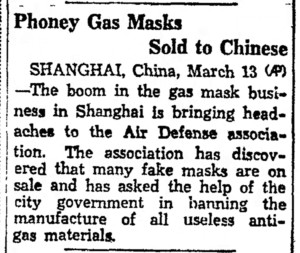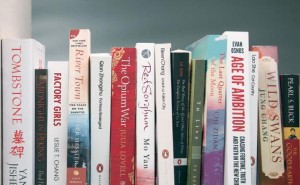Posted: April 4th, 2015 | No Comments »
I’ve blogged previously about Shirley Temple’s one outing to Shanghai, her speaking a bit of Chinese (and how she became a pioneer for Mandarin overseas) and her Pekingese dog in the film Stowaway (1936). Here’s a poster for the movie advertising Shirley in “Far-off Shanghai”…..

Posted: April 3rd, 2015 | No Comments »
March 1937 and Shanghai residents are terrified that Japan may attack the city. They’re right to be afraid, Japan is menacing China and in August war will break out and bombs fall on the city. Worried citizens look to buy gas masks in the hope that they may be able to protect themselves and their families in the event of a gas bomb attack from Japan. But the Shanghai Air Defense Association reports a problem – fake masks are being sold, masks that will be useless in the event of a gas attack. Unscrupulous war profiteers are selling useless equipment to desperate and frightened people that will offer them no protection. I won’t bore you with the parallels over the years, they’re all too obvious….

Posted: April 2nd, 2015 | No Comments »
Old Summer Palace Revealed Through Digital Technology
a unique RASBJ excursion

On April 4, you’re invited to this premiere tour of little-known sites in the Old Summer Palace, featuring digital recreations of imperial architecture, on Ipads and smartphones, brought exclusively to RASBJ by the Tsinghua Heritage Institute for Digitization (THID). We’re the first group to see THID’s unique presentation on efforts to bring the Yuanmingyuan ruins and gardens to digital life. Please join us on this custom-designed excursion to parts of western Yuanmingyuan, the Old Summer Palace, seldom visited by the public. The buildings were destroyed long ago, but THID’s experts and virtual reconstructions reveal how emperors, eunuchs and concubines lived daily life and observed festival rituals such as Qingming in a bygone era. Space is limited, please RSVP now!
WHEN: Saturday, April 4, 12:30 PM – 5:00 PM
WHERE: Our bus departs at 12:30 PM from the Hilton Hotel, N. Third Ring Road, (tel: 5865 5000, 400m north of Lufthansa Center) for transport to the ZAOYUAN GATE of Yuanmingyuan, where our tour begins at 2:00 PM. The return bus leaves from Yuanmingyuan South Gate at around 5:00 PM. If you’re using public transport, the nearest subway stops are Xiyuan – for the start – and Yuanmingyuan at the end.
RSVP: membership@rasbj.org PLEASE RSVP BY APRIL 1!
HOW MUCH:Â RMB 400 for RASBJ members, RMB 450 for non-members. This includes bus transport to/from and within Yuanmingyuan (RMB 150); tickets; the use of AV devices such as Ipads; a tea break and administration/curation.
NOTE: Travel inside Yuanmingyuan will be mostly by electric sight-seeing bus, with some walking on garden paths. Please wear appropriate shoes/hats, and bring water if desired.
Please see www.rasbj.org for details and updates. WE HOPE YOU CAN MAKE IT!

Posted: April 1st, 2015 | No Comments »
Huan Hsu’s newly published The Porcelain Thief looks interesting, a sort of Hare With Amber Eyes for Nanking? On my reading list anyway…

In 1938, with the Japanese army approaching from Nanking, Huan Hsu’s great-great grandfather, Liu, and his five granddaughters, were forced to flee their hometown on the banks of the Yangtze River. But before they left a hole was dug as deep as a man, and as wide as a bedroom, in which was stowed the family heirlooms.
Among their antique furniture, jade and scrolls, was Liu’s prized porcelain collection, one he had amassed over many years and which contained priceless imperial items. The vault was filled to its brim before being covered with a false floor and replanted with vegetation. The family’s flight across wartorn China, and the arrival of the Communists, would scatter them across the globe. Grandfather Liu’s treasure became family myth, from a time that no one wished to speak of – no one ever returned to find it.
Three years ago, Huan Hsu moved back to China from the US. Armed with only the slightest threads of family memory, he set out to discover the truth. His investigations will take him through China’s cultural past and present, of which porcelain is a unique linking thread. He will gather memories of the China of another age from elderly relatives, uncover the story of his family’s flight from the Japanese, and confront the contradictions of contemporary China.
The Porcelain Thief will combine Hsu’s fascinating record of his family history with accounts of great political and cultural changes, and perhaps reveal, at last, the secret hiding place of his grandfather’s porcelain.
Posted: March 31st, 2015 | 6 Comments »
I picked up a copy of Don Smith’s 1952 novel China Coaster the other day. It came to my attention because it has a few references to Shanghai before the revolution that interested me. However, Smith’s novel is quite interesting in that it does (aside from the more sensational aspects of the plot) describe a Shanghai shortly after the revolution where the old Shanghai of gangsters, white Russians, opium dealers and China Coast adventurers still co-exists with the new no-fun Reds, the brutal commissars and a Communist Party enslaved to Moscow and Mao. This fascinating period is under-written about and under-researched so Smith’s description of how worker grievances against foreign companies were upheld by Commun9st courts to force them to hand over their businesses, along woith ridiculously high “taxes” by the commies on foreign firms forced people to just dump their assets and flee. Smith also describes the last remnants of the White Russian community – many, stateless, didn’t manage to leave until the mid-1950s in some cases.
Much of the action of Smith’s book takes place on Wayside (now Huoshan Road) down in Hongkew, an area that did remain home to a number of foreigners into the 1950s – it was poor, indigent lodging houses and at a time when tramp steamers still docked occasionally and so sailors came ashore for the bars that remained in business. A couple of years later all this became impossible and went – of course some of the hotels (the East Asia) and lodging houses – still a few along Huoshan Road remained, but the foreigners all went.
I know nothing about Don Smith himself except that he wrote this book and quite a few others that were Cold War thrillers in the “Secret Mission” series. I believe he must have at least visited Shanghai at some point, while a book like China Coaster could conceivably be written without visiting Shanghai and based on nes reports (Malraux did it!!), I feel some of the more obscure but accurate points of China Coaster, such as scenes set in the old boating centre of Minghong betray some familiarity. If anyone knows I’d love to know.


Posted: March 30th, 2015 | No Comments »
Time Out magazine in Beijing has just done a poll of the best fiction and non-fiction China books of the last 100 years – I’ll admit I was both a judge and author of a nominated book. It’s an interesting list and, of course as these sorts of lists do, reflects a wide range of interests (some judges are a bit more current in their tastes, while others, i.e. me, tended to be a bit more solidly pre-49 in their selections). Anyway, you can see the final winners here with the individual judges nominations too….

Posted: March 29th, 2015 | No Comments »
I haven’t posted for a while about references to Chinese lanterns in books (I went through a spate of these a while back – use the search box if you’re remotely interested). Here’s one more Chinese lantern reference, this time from Arthur Koestler’s fictional country of Neutralia, an island of hope for refugees from fascism created in his 1943 novel Arrival and Departure. In 1941 Peter Slavek, escapes from his country (an unidentified Balkan republic), where the “Movement” has surrendered to a fascist dictatorship. In Neutralia (reminiscent of neutral Portugal – a daft name, Stephen Spender commented that “Names like that should not be allowed in novels!”) he meets another refugee Odette. Together they go for dinner in still-free and unoccupied Neutralia….
They were both silent. the little back garden was almost empty; it was dimly lit by Chinese lanterns which hung from a wire stretching between the palms. The patron brought them more wine. In the distance, miles away on the sea, a ship sounded its siren, plaintive like a wounded animal.



Posted: March 28th, 2015 | No Comments »
RAS SHANGHAI LECTUREÂ Â
Tuesday 31 March 2015
7:00 PM for 7:15 PM start
Radisson Blu Plaza Xingguo Hotel, Tavern Bar
78 XingGuo Road, Shanghai
WADE SHEPARD will speak on
“Ghost Cities of China”

Wade Shepard, Editor-in-Chief of the China Chronicle, will speak about his book Ghost Cities of China: The Story of Cities without People in the World’s Most Populated Country, which is part of the Zed Asian Arguments series.
Featuring everything from sports stadiums to shopping malls, hundreds of new cities in China stand empty, with hundreds more set to be built by 2030. Between now and then, the country’s urban population will leap to over one billion, as the central government kicks its urbanization initiative into overdrive. In the process, traditional social structures are being torn apart, and a rootless, semi-displaced, consumption orientated culture rapidly taking their place. Ghost Cities of China is an enthralling dialogue-driven, on-location search for an understanding of China’s new cities and the reasons why many currently stand empty.
Talk Cost: RMB 70.00 (RAS members) and RMB 100.00 (non-members). Includes glass of wine or soft drink. Those unable to make the donation but wishing to attend may contact us for exemption.
Membership applications and membership renewals will be available at this event. Those unable to make the donation but wishing to attend may contact us for exemption.
RAS Monographs: Series 1 & 2 will be available for sale at this event. RMB 100 each (cash sale only).
To RSVP:Â Please “Reply” to this email or write to
RAS Bookings at: bookings@royalasiaticsociety.org.cn











